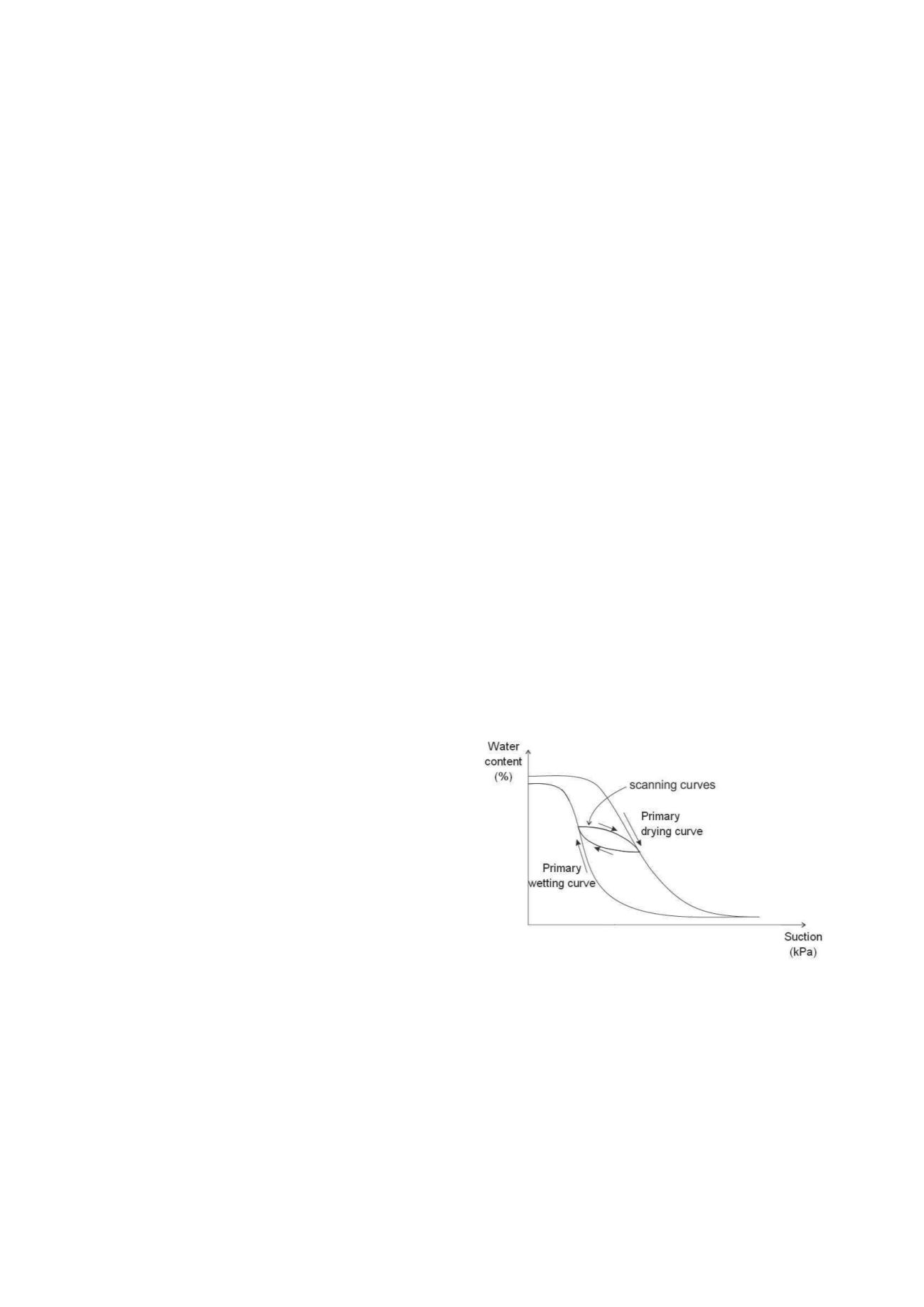
1155
Influence of initial water content on the water retention behaviour of a sandy clay
soil
Influence de la teneur en eau initiale sur le comportement de rétention d'eau d'une argile sableuse
Mendes J.
The University of Newcastle, Newcastle, Australia (formerly Durham University, Durham, United Kingdom)
Toll D.G.
Durham University, Durham, United Kingdom
ABSTRACT: In order to model the impact of climate changes on the infrastructure for the built environment, such as embankments
and cuttings, an understanding of the water retention behaviour is required. To this end, a series of filter paper tests were carried out
on remoulded samples of a sandy clay material of medium plasticity. The soil samples were prepared with different initial water
contents and dynamically compacted. Filter paper tests were performed to determine the soil water retention curve (SWRC) from a
saturated state. Other subsamples were wetted or dried to reach different water contents for testing. The obtained results were then
compared with the SWRC. The drying tests showed typical behaviour of scanning curves, however the wetting curves showed
untypical behaviour, where the curves appeared to overlap each other with no clear pattern. The observed behaviour from laboratory
samples can be extrapolated to field conditions, where future climate change will have a major impact on the water retention
behaviour on earth structures, which will have implications for the geo-mechanical behaviour.
RÉSUMÉ : L'impact du changement climatique sur les constructions géotechniques, comme les remblais/déblais, doit être
appréhendé. Dans cette optique, une série d’essais par la méthode du papier filtre a été réalisée sur des échantillons reconstitués
d'une argile sableuse à plasticité moyenne, afin d'analyser les conséquences sur la courbe de rétention d'eau du sol. Le matériau a été
préparé avec des teneurs en eau initiales différentes afin d'obtenir des échantillons par compactage dynamique. Ces échantillons ont
été utilisés soit directement pour effectuer la méthode du papier filtre, soit leur teneur en eau a été modifiée après compactage. Les
résultats obtenus ont alors été comparés avec la courbe de rétention d'eau. Les tests en séchage montrent un comportement classique
sur les courbes de transitions, alors que ceux en humidification montrent un comportement atypique puisque les courbes se croisent
sans donner une tendance claire. A partir des résultats expérimentaux, une extrapolation peut être réalisée concernant le comportement
des ouvrages géotechniques, où les changements climatiques futurs auront des répercussions sur le comportement hydromécanique du
sol.
KEYWORDS: Filter paper, SWRC, Scanning curves
1 INTRODUCTION.
Earth structures (i.e. road embankments, railway embankments,
earth dams and flood defences) can fail when pore water
pressures increase significantly (and soil suction drops)
following intense rainfall or flooding. With predicted changes in
climate patterns, such failures are likely to become more
frequent with significant economic implications. The 4th
Assessment Report of IPCC (IPCC, 2007) states: “Continued
greenhouse gas emissions at or above current rates would cause
further warming and induce many changes in the global climate
system during the 21st century that would very likely be larger
than those observed during the 20th century”. The increased
global warming will affect climate patterns, with longer and
drier summers followed by wetter winters with more intense
storms predicted for UK and northern Europe. To model the
impact of these changes in climate on earth structures requires
an understanding of the water retention behaviour.
The water retention behaviour can be characterized by
determining the soil water retention curve (SWRC) for a
specific soil. A SWRC is defined from the relationship between
water content and suction. The water content can be expressed
either as gravimetric water content, w, volumetric water
content, θ or even degree of saturation, S
r
. A SWRC is typically
S-shaped and is hysteretic (Figure 1), meaning that for a given
water content, higher suctions can be obtained when following a
drying path than following a wetting path. In some cases a soil
may not follow a continuous path from a totally dried or totally
wet state. It is very common to find soils in an intermediate
Figure 1. Hysteretic characteristics of a Soil Water Retention Curve
(after Lourenço, 2008).
state when the direction of water content change is reversed.
These intermediate stages are known as scanning curves. In
Figure 1 two kinds of scanning curves are presented as simple
examples: an ascending scanning curve where the initial
condition was reached while following a drying path and was
subsequently wetted and a descending scanning curve where the
intermediate stage starts on the wetting path of the SWRC and
the material gradually dries until the drying path of the SWRC
is reached. In reality any point between the primary wetting and
drying paths can exist, but by following wetting or drying the
curve will eventually converge with one of the primary paths of
the SWRC.


